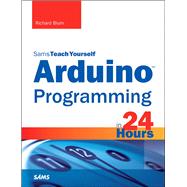Arduino Programming in 24 Hours, Sams Teach Yourself

Arduino Programming in 24 Hours, Sams Teach Yourself
- ISBN 13:
9780672337123
- ISBN 10:
0672337126
- Edition: 1st
- Format: Paperback
- Copyright: 08/21/2014
- Publisher: Sams Publishing
Note: Supplemental materials are not guaranteed with Rental or Used book purchases.
Extend or Purchase Your Rental at Any Time
Need to keep your rental past your due date? At any time before your due date you can extend or purchase your rental through your account.
Summary
In just 24 sessions of one hour or less, Sams Teach Yourself Arduino Programming in 24 Hours teaches you C programmingon Arduino, so you can start creating inspired “DIY” hardwareprojects of your own! Using this book’s straightforward, step-by-stepapproach, you’ll walk through everything from setting up yourprogramming environment to mastering C syntax and features, interfacing your Arduino to performing full-fledged prototyping.Every hands-on lesson and example builds on what you’ve alreadylearned, giving you a rock-solid foundation for real-world success!
Step-by-step instructions carefully walk you through the most common Arduino programming tasks.
Quizzes at the end of each chapter help you test your knowledge.
By the Way notes present interesting information related to the discussion.
Did You Know? tips offer advice or show you easier ways to perform tasks.
Watch Out! cautions alert you to possible problems and give you advice on how to avoid them.
Learn how to...
- Get the right Arduino hardware and accessories for your needs
- Download the Arduino IDE, install it, and link it to your Arduino
- Quickly create, compile, upload, and run your first Arduino program
- Master C syntax, decision control, strings, data structures, and functions
- Use pointers to work with memory—and avoid common mistakes
- Store data on your Arduino’s EEPROM or an external SD card
- Use existing hardware libraries, or create your own
- Send output and read input from analog devices or digital interfaces
- Create and handle interrupts in software and hardware
- Communicate with devices via the SPI interface and I2C protocol
- Work with analog and digital sensors
- Write Arduino C programs that control motors
- Connect an LCD to your Arduino, and code the output
- Install an Ethernet shield, configure an Ethernet connection, and write networking programs
- Create prototyping environments, use prototyping shields, and interface electronics to your Arduino








